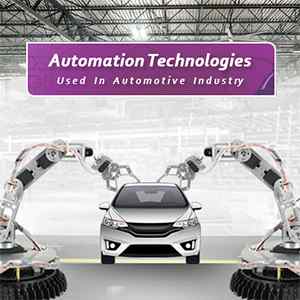Application of Robotic Automation in Manufacturing Industry

Application of Robotic Automation in Industries
Robotic industrial automation has redefined the complete production mechanism in the business world. Manufacturers around the globe are imbibing automation into their respective units, to emerge as self-sufficient, and procure a safer environment, which would, in turn, increase the revenues. Application of robotic automation finds its place in the following industries:
1. Automotive
Robotic automation enables automotive plants to deal with labour shortages. They are perfect substitutes for manufacturers who help them to get more work done in less time. The robots used for robotic automation have inbuilt safety features, that stop them from moving whenever humans get closer.
2. Electronics Manufacturing
There has been a steep rise in the demand of smart phones, flat-screen TVs, earbuds, and tablets, among other gadgets. China has capitalized on robotic automation in the electronics manufacturing sector. Between 2013 and 2014, the robots working in that industry more than doubled in China.
3. Medical
Health facilities have also benefited from automated robots. In the San Francisco Bay area, one hospital is using dozens of robots, called TUGs, to transport supplies and medications.
Robots are also helping surgeons perform operations. One flesh-cutting semi-autonomous robot performed better than humans regarding precision and reduction of damage to the surrounding skin.
4. Welding
Robotic welding equipment reduces waste and delivers fast, high-quality results without direct human involvement.
The Japanese had developed Motoman Robot, the company doubled its output and transitioned several of its welders to other tasks.
5. Food Service
The use of robots in food services has been the latest talk of the town. Due to several factors like new minimum wage requirements and the rising cost of raw materials, restaurants increasingly use robots to make tasks more uniform and efficient.
A fine example is Little Caesar’s patented a robotic arm that spreads the dough, adds toppings, and places pizzas in the oven. At chain restaurants, in particular, people expect an identical experience whether the outlet is in Texas or Taiwan. Automation is helping meet that goal, thanks to robots that perform without fail while carrying out the orders built into their programming.
6. Law Enforcement
In the first half of 2016, 201 robots were transferred from military service to local law enforcement agencies, in the United States of America.
The robots are used for policing purpose, and these do not exhibit deadly force. Instead, they primarily defuse bombs, gather details about dangerous situations, and report back to the human police officers who will carry out further investigation.
The Relevance of Robotic Automation In The Manufacturing Industry
Robots used in production, perform numerous roles. Fully efficient robots in manufacturing, are usually required for high volume, repetitive processes, in which the speed, accuracy and sturdiness of robots offer unparalleled advantages. Other manufacturing automation solutions encompass, robots used to assist human beings with greater elaborate tasks. A robot carries out different tasks, some of them include lifting, protecting and shifting heavy pieces.
Robotic system automation in production allows companies to remain competitive globally. Thus, providing an efficient, possible opportunity to offshoring and pleasant the skills hole in areas where it can be difficult to recruit the necessary manpower.
Manufacturing robots enable industrialists to focus on innovation and performance, which is of greater intricate tactics that in the end lay the groundwork for success. With a devoted production automation solution, multiplied productivity, safety within the manufacturing unit can be achieved with quality control factor.
Industrial Facts:
1. The Industrial Robotics Market size (including the prices of peripherals, software, and system engineering) is expected to grow from USD 48.7 billion in 2019 to USD 75.6 billion by 2024; it is expected to grow at a CAGR of 9.2% during the forecast period.
2. Technological developments and decreasing costs are making industrial robots more affordable to SMEs and are enabling seamless integration and programming.
Advantages of Robotic Automation
Listed below are some of the qualitative advantages of using robotic automation in manufacturing industries.
1. Quality Control
Robots are one of the finest solutions for higher quality production. Quality plays an important role in building trust from customers.
2. Repeatability
Robots have the efficiency and capacity to produce the same quality end product for a repeated number of times. Thereby, decreasing the time of production and minimizing the chances of error.
3. Waste Reduction
Persistent repeatability in the manufacturing process, allows manufacturers to reduce overall waste. Fewer errors not only saves time, but it also reduces the amount of material required to produce the product. A couple of examples: robots can use less wire for welding, less amount of paint, and cut closer to the edge.
4. Improved Workplace Safety
There are many manufacturing units, whose environment are dangerous, and can cause damage to the body of human beings. Separating workers from lifting too much weight, exposure to fumes and gases, close interaction with lasers or blades, can tremendously decrease the possibility of injury.
5. Integration with Business Systems
Communication between multiple data systems is essential for improved efficiency in the manufacturing industry. Robots and machinery are talking with one another to give business leaders a better view of the overall picture, helping them make smarter decisions on how to improve their process.











